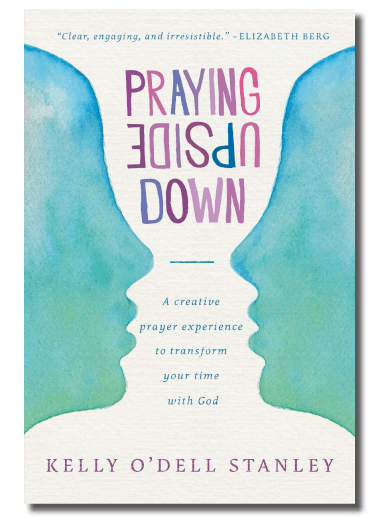Short story is that I committed to review a book and my time became out of control busy! I prayed for help and the Holy Spirit prompted me to ask my dear friend Beth Moore to check it out for me & see what she thought! Turns out, she was blessed by it, and of course, so was I. I think you will be, too!
Isn’t that just like our good Father? Thank you, Lord! and Thanks, Beth!
Guest Book Review by Beth Q. Moore
PRAYING UPSIDE DOWN By Kelly O’Dell Stanley
How do you pray upside down? Could this be a spiritual yoga experience? A one-too-many glass of wine sort of praying experience? Praying upside down is certainly not what I expected it would be.
The author, Kelly O’Dell Stanley, is an artist/business woman raised by an artist father. She has spent her entire life exposed to and influenced by perspective. How many times have you been unable to see/believe/accept a concept, but experienced an ah-ha moment after someone else pointed out a different way of looking at the issue? For me, this happens a lot. We all get stuck in a comfortable way of dealing with life and settle in a pattern of predictable responses to life’s curve balls. The author urges us to break free from our customary response modes and to discover a way to refresh and expand our prayer life. I’m all in for that!
Ok, back to perspective. What does this have to do with prayer? Most of us get so frustrated at times with our inability to say in prayer what we truly feel that we essentially quit praying and command God to fix us: “God, please cure my daughter’s addiction; Help me get the job so I can pay the rent? Just heal my sister of this cancer; Give me peace from my depression.” We become exhausted with our problems, and in our desperation, we give God a grocery list and beg for Him to deliver. Stanley suggests that in praying upside down, we change our perspective and pray for the person(s) on the other side of our needs.
She “painted” – pun intended—the beautiful example of the time she needed to sell her house and was going broke because she had two mortgages. In her praying, God spoke to her and urged her to pray instead for the woman who was destined to buy her house. Yes, the woman. God was specific. Trusting God, Stanley prayed in that manner. Prayer focus of this nature took the attention away from Stanley’s personal worries and placed it on someone else who also needed prayer. The other woman relocated to Stanley’s town and soon found out that her husband wanted a divorce. She needed to buy her own home. Stanley discovered that praying for herself evolved into praying for someone else who also urgently needed answer to a prayer. Perspective, looking at the situation from the point of view of another person who is involved in your particular prayer circumstance, eventually led to Stanley’s selling her house to that woman. Yes, a woman!
Similarly, any of us can apply this upside down concept to situations in which we have been hurt, angered, or disappointed. Don’t we tend to pray for our side of the story and forget that there is someone else on the other side, someone who may be hurting as much as we are? In praying for someone else, we can’t help but start a dialogue with God about perspective issues: selflessness, acceptance, understanding, and cooperation.
Blind Contour Drawing — drawing the outline of a subject without ever looking down at the paper or lifting the pencil — is another artist skill that the author compares to prayer. This drawing method forces the artist to keep her eyes on the subject at all times. Likewise, in prayer and in all aspects of life, we need to keep our eyes and our focus on God. This forces us to look to God, not to ourselves, for direction and strength and to take our attention from our worries, fears, dread, or pain. If we focus on God and not on our problems, we will see Him. That’s what He wants. He wants us to see Him and He wants us to talk with Him unceasingly.
Stanley likens art to prayer in so many more ways: minimalism, symbolism, simplicity, pointillism, and realism. Savor this book; take a chapter a week and apply Stanley’s concepts to your prayer life. I know I have already begun to pray upside down in that I have begun to focus some of my prayers on the people on the opposite side of my prayer issues. And quite honestly, sometimes this is not easy. Some of the people on the other side of my prayer needs are people whom I do not particularly like or respect. However, the feeling I get after such prayers is incredibly powerful and liberating. I thoroughly enjoyed this book and I thank the lovely sister friend who loaned it to me.


I just saw this review and I want to say thank you to both you and Beth! I loved the review and the way she described the concepts… just know that I am grateful for the time and effort and that you’ve blessed me with these kind words.
Kelly! The best part is that the Holy Spirit prompted me to share it with Beth and she was amazed that the concepts were an answer to her prayers at the present time! I love how He always meets our need. He is faithful!
Thank you for a beautiful work! We love it! And Beth has a lovely gift with words!